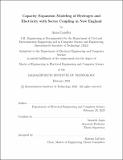| dc.contributor.advisor | Amin, Saurabh | |
| dc.contributor.author | Landler, Anna | |
| dc.date.accessioned | 2023-03-31T14:35:53Z | |
| dc.date.available | 2023-03-31T14:35:53Z | |
| dc.date.issued | 2023-02 | |
| dc.date.submitted | 2023-02-27T18:43:21.797Z | |
| dc.identifier.uri | https://hdl.handle.net/1721.1/150150 | |
| dc.description.abstract | Alternative fuels are necessary to achieve decarbonization, especially of sectors outside of electricity supply. Hydrogen is a promising energy carrier due to its flexibility of storage and transmission and applicability to a wide range of sectors. We model a case study of New England to investigate how infrastructure might be adapted and built out to support such a system. We then incorporate a model of the current electrical system to investigate synergies between the two. We find that projected technology improvements are insufficient to promote electrolysis at the utility scale. Further cost reductions in electrolysis or cheap imports of clean energy will be needed. Notably, SMR with CCS is a dominant method of meeting hydrogen demand; the specifics of CCS are an important avenue for future work. We find that the region is very sensitive to availability and cost imports. As such, any considerations for energy development in New England ought to be put in context of developments in the surrounding areas. | |
| dc.publisher | Massachusetts Institute of Technology | |
| dc.rights | In Copyright - Educational Use Permitted | |
| dc.rights | Copyright MIT | |
| dc.rights.uri | http://rightsstatements.org/page/InC-EDU/1.0/ | |
| dc.title | Capacity Expansion Modeling of Hydrogen and Electricity with Sector Coupling in New England | |
| dc.type | Thesis | |
| dc.description.degree | M.Eng. | |
| dc.contributor.department | Massachusetts Institute of Technology. Department of Electrical Engineering and Computer Science | |
| mit.thesis.degree | Master | |
| thesis.degree.name | Master of Engineering in Electrical Engineering and Computer Science | |
